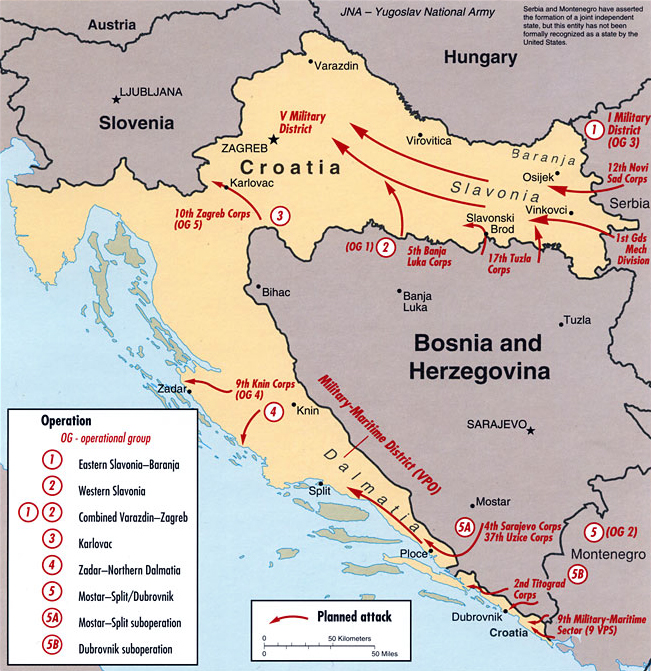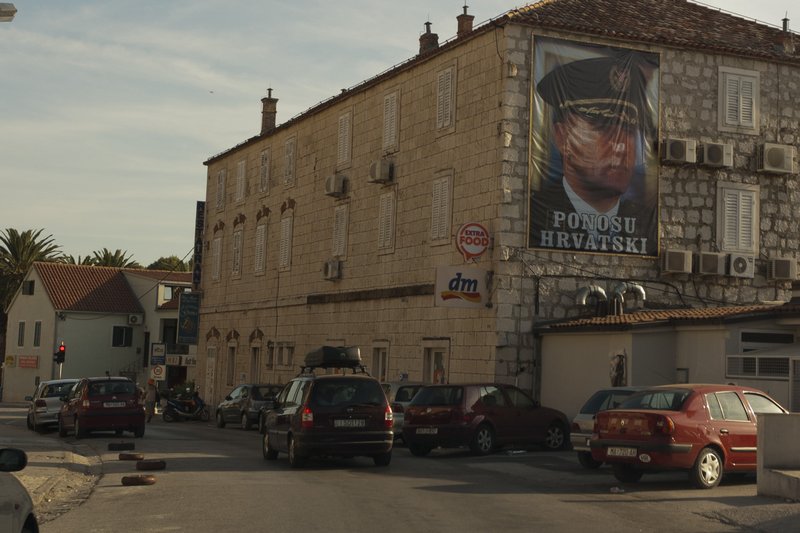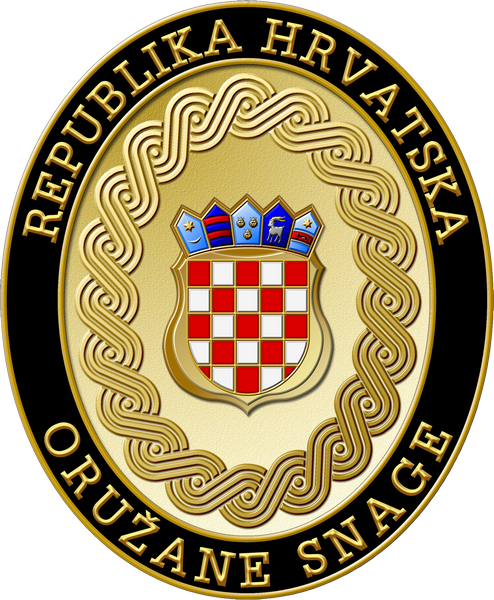|
Operation Winter '94
Operation Winter '94 (, Операција Зима '94) was a joint military offensive of the Croatian Army (HV) and the Croatian Defence Council (HVO) fought in southwestern Bosnia and Herzegovina between 29 November and 24 December 1994. The operation formed part of the Croatian War of Independence and the Bosnian War fought between Bosnia and Herzegovina, Croatia and two unrecognized para-states proclaimed by Croatian Serbs and Bosnian Serbs. Both para-states were supported by the Yugoslav People's Army (JNA) and Serbia. The JNA pulled out in 1992, but transferred much of its equipment to the Bosnian Serb and Croatian Serb forces as it withdrew. Operation Winter '94 was the first in a series of successful advances made by the HV and the HVO in or near the Livanjsko field, an elongated flat-bottomed valley surrounded by hills. The region was formally controlled by the HVO, but the HV contributed a substantial force, including commanding officers. The attacks were primari ... [...More Info...] [...Related Items...] OR: [Wikipedia] [Google] [Baidu] |
Croatian War Of Independence
The Croatian War of Independence) and (rarely) "War in Krajina" ( sr-Cyrl-Latn, Рат у Крајини, Rat u Krajini) are used. was an armed conflict fought in Croatia from 1991 to 1995 between Croats, Croat forces loyal to the Government of Croatia—which had declared Independence of Croatia, independence from the Socialist Federal Republic of Yugoslavia (SFRY)—and the Serbs, Serb-controlled Yugoslav People's Army (JNA) and Serbs of Croatia, local Serb forces, with the JNA ending its combat operations by 1992. A majority of Croats supported Croatia's independence from Yugoslavia, while many ethnic Serbs living in Croatia, supported by Republic of Serbia (1992–2006), Serbia, opposed the secession and advocated Serb-claimed lands to be in a common state with Serbia. Most Serbs sought a new Serb state within a Yugoslav federation, including areas of Croatia and Bosnia and Herzegovina with ethnic Serb majorities or significant minorities, and attempted to conquer as muc ... [...More Info...] [...Related Items...] OR: [Wikipedia] [Google] [Baidu] |
Šipovo
Šipovo ( sr-cyrl, Шипово) is a town and municipality in Republika Srpska, Bosnia and Herzegovina. It is situated in the southern part of the Bosanska Krajina region. As of 2013, it has a population of 10,293 inhabitants, while the town of Šipovo has a population of 4,052 inhabitants. The municipality covers an area of , much of which is forested. History The Glogovac monastery of the Serbian Orthodox Church is near the town. Geography It is located between the municipalities of Mrkonjić Grad to the west, Jezero, Republika Srpska, Jezero to the north, Jajce and Donji Vakuf to the east, and Kupres, Republika Srpska, Kupres (Republike Srpske) and Glamoč to the south. In the broader geographical sense, the town of Šipovo is located at 44°28’ north and 17°08’ east, having a moderate continental climate. In the narrower geographical sense, Šipovo is located in southeastern part of Republika Srpska, with the total area of , and with a population of 11,000. The po ... [...More Info...] [...Related Items...] OR: [Wikipedia] [Google] [Baidu] |
Ante Gotovina
Ante Gotovina (born 12 October 1955) is a Croatian retired lieutenant general and former French senior corporal who served in the Croatian War for Independence. He is noted for his primary role in the 1995 Operation Storm. In 2001, the International Criminal Tribunal for the former Yugoslavia (ICTY) indicted him on war crimes and crimes against humanity charges in connection with that operation and its aftermath. After spending four years in hiding, he was captured in the Canary Islands in December 2005. On 15 April 2011, Gotovina was found guilty on 8 of the 9 counts of the indictment and sentenced to 24 years of imprisonment. On 16 November 2012, Gotovina's convictions were overturned by an appeals panel at the International Criminal Tribunal for the former Yugoslavia (ICTY) and he was released from custody. Early life Ante Gotovina was born in Tkon on the island of Pašman. His father Milan tried to move with his mother to Italy, but was caught by the Yugoslav border poli ... [...More Info...] [...Related Items...] OR: [Wikipedia] [Google] [Baidu] |
Janko Bobetko
Janko Bobetko (10 January 1919 – 29 April 2003) was a Croatian general who had participated in World War II and later in the Croatian War of Independence. He was one of the founding members of 1st Sisak Partisan Detachment, the first anti-fascist military unit during World War II in Yugoslavia. He later had a military career in the Yugoslav People's Army (JNA). In 1992, Bobetko became the Chief of the General Staff of the Croatian Army (HV). He served in this capacity until his retirement in 1995. Bobetko had been charged with war crimes by the International Criminal Tribunal for the former Yugoslavia but died before he could be tried; a later verdict in another case found that he took part in the joint criminal enterprise against the non-Croat population during the Bosnian War. Biography Bobetko was born in the village of Crnac, Sisak in the Kingdom of Serbs, Croats and Slovenes. [...More Info...] [...Related Items...] OR: [Wikipedia] [Google] [Baidu] |
Tihomir Blaškić
Tihomir Blaškić (born 2 November 1960) is a retired general of the Croatian Defence Council (HVO), who served during the Bosnian War and the Croat–Bosniak War. The International Criminal Tribunal for the Former Yugoslavia (ICTY) indicted him on war crimes charges and in 2000 he was sentenced to 45 years of prison. In July 2004, the ICTY, on appeal, determined that his command responsibility for most of the charges was non-existent and his sentence was lessened to nine years imprisonment. He was released the following month. Early life Tihomir Blaškić was born on 2 November 1960Profile , ess.uwe.ac.uk; accessed 13 April 2015. in the village of Brestovsko in the Kiseljak municipality of |
Bosnia And Herzegovina
Bosnia and Herzegovina, sometimes known as Bosnia-Herzegovina and informally as Bosnia, is a country in Southeast Europe. Situated on the Balkans, Balkan Peninsula, it borders Serbia to the east, Montenegro to the southeast, and Croatia to the north and southwest, with a coast on the Adriatic Sea in the south. Bosnia (region), Bosnia has a moderate continental climate with hot summers and cold, snowy winters. Its geography is largely mountainous, particularly in the central and eastern regions, which are dominated by the Dinaric Alps. Herzegovina, the smaller, southern region, has a Mediterranean climate and is mostly mountainous. Sarajevo is the capital and the largest city. The area has been inhabited since at least the Upper Paleolithic, with permanent human settlement traced to the Neolithic cultures of Butmir culture, Butmir, Kakanj culture, Kakanj, and Vučedol culture, Vučedol. After the arrival of the first Proto-Indo-Europeans, Indo-Europeans, the area was populated ... [...More Info...] [...Related Items...] OR: [Wikipedia] [Google] [Baidu] |
Croatia
Croatia, officially the Republic of Croatia, is a country in Central Europe, Central and Southeast Europe, on the coast of the Adriatic Sea. It borders Slovenia to the northwest, Hungary to the northeast, Serbia to the east, Bosnia and Herzegovina and Montenegro to the southeast, and shares a maritime border with Italy to the west. Its capital and largest city, Zagreb, forms one of the country's Administrative divisions of Croatia, primary subdivisions, with Counties of Croatia, twenty counties. Other major urban centers include Split, Croatia, Split, Rijeka and Osijek. The country spans , and has a population of nearly 3.9 million. The Croats arrived in modern-day Croatia, then part of Illyria, Roman Illyria, in the late 6th century. By the 7th century, they had organized the territory into Duchy of Croatia, two duchies. Croatia was first internationally recognized as independent on 7 June 879 during the reign of Duke Branimir of Croatia, Branimir. Tomislav of Croatia, Tomis ... [...More Info...] [...Related Items...] OR: [Wikipedia] [Google] [Baidu] |
Army Of The Republic Of Bosnia And Herzegovina
The Army of the Republic of Bosnia and Herzegovina (; ; ARBiH), often referred to as Bosnian Army, was the military force of the Republic of Bosnia and Herzegovina. It was established by the government of the Republic of Bosnia and Herzegovina in 1992 following the outbreak of the Bosnian War. Following the end of the war, and the signing of the Dayton Peace Agreement in 1995, it was transformed into the Army of the Federation of Bosnia and Herzegovina. The ARBiH was the only military force on the territory of Bosnia and Herzegovina recognised as legal by other governments. Under the State Defense Reform Law the Armed Forces of Bosnia and Herzegovina were unified into a single structure, the Armed Forces of Bosnia and Herzegovina (OSBiH), making entity armies defunct. History Creation and composition The Army of Republic of Bosnia and Herzegovina was formed on 15 April 1992 during the early days of the Bosnian War. Before the ARBiH was officially created, a number of para ... [...More Info...] [...Related Items...] OR: [Wikipedia] [Google] [Baidu] |
Army Of Republika Srpska
The Army of Republika Srpska (; ВРС/VRS), commonly referred to in English as the Bosnian Serb Army, was the military of Republika Srpska, the self-proclaimed Serb secessionist republic, a territory within the newly independent Bosnia and Herzegovina (formerly part of Yugoslavia), which it defied and fought against. Active during the Bosnian War from 1992 to 1995, it continued to exist as the armed forces of RS, one of two entities making up Bosnia and Herzegovina, until 2006 when it was integrated into the Armed Forces of Bosnia and Herzegovina. Forces of the VRS engaged in several campaigns, including Operation Corridor 92, Operation Vrbas '92, Operation Bura, and Operation Spider; they were also involved in the siege of Sarajevo, as well as the Srebrenica massacre. Personnel The Army of the Republika Srpska (VRS) was founded on 12 May 1992 from the remnants of the Yugoslav People's Army (JNA) of the former Socialist Federal Republic of Yugoslavia from which Bosnia an ... [...More Info...] [...Related Items...] OR: [Wikipedia] [Google] [Baidu] |
Croatian Defence Council
The Croatian Defence Council (, HVO) was the armed wing of the self-proclaimed Croatian Republic of Herzeg-Bosnia, a breakaway entity unrecognised by the international community and accused of ethnic-based violence during the conflict. It existed in the Republic of Bosnia and Herzegovina between 1991 and 1996. The HVO was the main military force of the Croats of Bosnia and Herzegovina. In the initial stage of the Bosnian War, the HVO fought alongside the Army of the Republic of Bosnia and Herzegovina (ARBiH) against the Army of Republika Srpska, but in the latter stage of the conflict clashed against its former ally, particularly in the Mostar area. The European Community Monitoring Mission estimated the strength of the HVO in the beginning of 1993 at 45,000–55,000. In July 1993, the Central Intelligence Agency estimated the HVO forces at 40,000 to 50,000 men. The HVO was incorporated into the Army of the Federation of Bosnia and Herzegovina (VFBiH) in December 1995 by fo ... [...More Info...] [...Related Items...] OR: [Wikipedia] [Google] [Baidu] |
Army Of The Republic Of Serb Krajina
The Serbian Army of Krajina (SAK, sh-Latn-Cyrl, Srpska vojska Krajine, Српска војска Крајине, abbr. SVK), also known as the Army of the Republic of Serbian Krajina or Krajina Serbian Army, was the armed forces of the Republic of Serbian Krajina (RSK). The SVK consisted of ground and air elements. Created through the merger of the Territorial Defense (Yugoslavia), Territorial Defense of the Republic of Serbian Krajina (TORSK), units of the Yugoslav People's Army (JNA) and the Krajina Militia, the SVK was officially established on 19 March 1992. Responsible for the security of the RSK, its area of responsibility covered an area of some 17,028 km² at its peak, as it was located entirely inland it thus had no naval forces. The SVK, along with the state of RSK, ceased to exist in 1995 following the Croatian military offensive Operation Storm. Organization Commanders-in-Chief Commanders Structure * 105th Aviation Brigade * 44th Air defen ... [...More Info...] [...Related Items...] OR: [Wikipedia] [Google] [Baidu] |
Croatian Army
The Croatian Army ( or HKoV) is the land force branch of the Croatian Armed Forces. It is numerically the largest of the three branches of the Croatian Armed Forces. The HKoV is the main force for the defense of the country against external threats, and in addition to the task of defending the Republic of Croatia, the HKoV also has the task of participating in peace support operations and humanitarian operations as part of international forces, as well as the task of preventing and eliminating the consequences of emergency situations in the country caused by natural and technical accidents and disasters. The HKoV has units of combat branches (Mechanized and Armoured Mechanized infantry), combat support branches (artillery, air defense, engineering, communications, nuclear-biological-chemical defense, military police and military intelligence units) and services support (supply, transport, maintenance and sanitation). Role and Deployment The basic mission of HKoV is to defend th ... [...More Info...] [...Related Items...] OR: [Wikipedia] [Google] [Baidu] |



